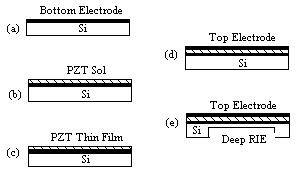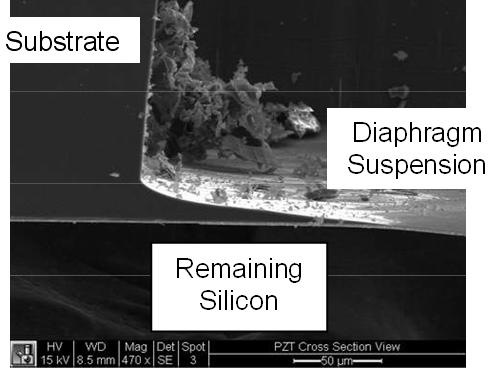Zinc-Zirconium-Titanium oxide (PZT) is a piezoelectric ceramics with high piezoelectric constants often used as sensors and actuators. Our research objective in this area is to develop PZT thin-film micro-sensors and actuators. One application is tiny acoustic actuators that fit into cochlea (part of inner ear) to generate significant acoustic stimulation as implantable hearing aids. Such actuators, when combined with shortened cochlear implant electrodes, have the advantage of better speech recognition in noisy environments. Furthermore, the combined acoustic and electric cochlear implants will have coordinated post-surgical mapping, single device to care for, more effective acoustic stimulation, and no occlusive effects.
We have been developing acoustic micro-actuators for intracochlear applications since 2004. Our research efforts include design, fabrication, prototyping, instrumentation and measurements. Some preliminary results are summarized as follows.
 |
 |
A. Conceptual Design. Figure 1 shows the cross sectional view of a PZT thin-film acoustic microactuator. The design consists of a silicon substrate, a diaphragm suspension, a PZT thin film, and a top and a bottom electrode. When a voltage V(t) is applied across the PZT film, the contraction and extension of the PZT film cause the diaphragm to vibrate in the out-of-plane direction emitting pressure waves. Our most recent design has a diaphragm size of 800 μm x 800 μm and a thickness (including the PZT thin film) of 1.3 μm.
B. Fabrication, Prototypes and Measurements. Figure 2 illustrates the fabrication process using an improved sol-gel process that employs rapid thermal annealing and a dilute sealant coating. The silicon substrate is first oxidized in a furnace at 1045°C for 2 hours to grow a SiO2 layer of 500 nm thick. Then a layer silicon nitride of 200 nm thick is deposited by PECVD (plasma enhanced chemical vapor deposition). The bottom electrode consists of Pt/Ti layers with thickness of 100 nm and 50 nm, respectively (Fig. 2(a)). The PZT film is spin-coated three times. For the first two coatings, the sintering temperature is 650°C for 15 minutes. For the third coating, the sol is diluted 50% by acetic acid and sintering temperature is 450°C for 10 minutes (Fig. 2(b) and (c)). The top electrode consists of Au/Cr layers through evaporation (Fig. 2(d)). Finally, the backside of the silicon is etched via deep reactive ion etch (DRIE) to form the diaphragm suspension (Fig. 2(e)). The thickness of the PZT film is measured around 1 μm. The PZT film surface is crack-free and smooth; see the SEM photo in Fig. 3. Moreover, Fig. 4 shows the SEM photo of an actuator/microphone prototype.
 |
 |
 |
The PZT thin film is then poled under 10 V for 30 minutes. For our PZT thin films, the dielectric constant is usually around 200 to 300 at 1 kHz. To evaluate the performance of the microactuator, the PZT thin film is driven at 3 kHz with 5-V amplitude. Figure 5 shows that the out-of-plane displacement of the microactuator is roughly 70 nm as measured from a laser Doppler vibrometer (LDV).
C. Finite Element Analysis. We have also conducted a finite element analysis (FEA) to design a better actuator. We note that the diaphragm suspension is not uniformly etched near the silicon substrate; see Fig. 6. Therefore, the finite element model consists of five parts: a circular uniform diaphragm, a non-uniform remaining silicon structure, and a square surrounding substrate, a PZT thin film above the other three parts, and a top electrode; see Fig. 7. Moreover, a static electric potential is applied at the top and bottom surfaces of the PZT thin film corresponding to the area of the electrodes. Then the static deflection at the center of the diaphragm is calculated. Since the resonance frequency of the actuator is more than 70 kHz, a static analysis is sufficient to predict the amplitude of the actuator at 3 kHz for example.
Through the FEA, we have identified two critical parameters that dominate actuator displacement. They are the size of the top electrode and the size of the remaining silicon. The FEA results in Fig. 8 predict the actuator displacement with respect to the size of a square electrode. Each curve in Fig. 8 corresponds to a remaining silicon structure with a given inner diameter. The FEA leads to two important results. First, the top electrode has an optimal size maximizing the actuator displacement for a given size of remaining silicon. Second, the size of the remaining silicon can significantly affect the maximal displacement of the actuator.
 |
 |
 |
 |
We have also conducted an experiment to verify the FEA predictions. First, PZT thin-film microactuators are fabricated, poled, and measured according to the procedure described in Section B above. Then the microactuators are screened according to the size of their remaining silicon. Figure 9 shows the measured actuator displacement vs. electrode size, when the inner diameter of the remaining silicon is between 500 μm and 600 μm. The experimental measurements confirm that there is an optimal size of the top electrode to maximize the actuator displacement.
Major Publications
- Yi-Chu Hsu, Chia-Che Wu, Cheng-Chung Lee, G. Z. Cao, and I. Y. Shen, 2004: Demonstration and Characterization of PZT Thin-Film Sensors and Actuators for Meso- and Micro-Structures. Sensors and Actuators A physical, Vol. 116, No. 3, pp. 369-377.
- Chia-Che Wu, Cheng-Chung Lee, G. Z. Cao, and I. Y. Shen, 2006: Effects of Corner Frequency on Bandwidth and Resonance Amplitude In Designing PZT Thin-Film Actuators. Sensors and Actuators A physical, Vol. 125, pp. 178-185.
- I. Y. Shen, G. Z. Cao, Chia-Che Wu, and Cheng-Chun Lee, 2006: PZT Thin-Film Meso- and Micro Devices: Challenges, Innovation, and Design Considerations. Ferroelectrics, Vol. 343 (1), pp. 15-34.
- Cheng-Chun Lee, Qing Guo, G. Z. Cao, and I. Y. Shen, 2008: Effect of Electrode Size and Silicon Residue on Piezoelectric Membrane Actuators. Sensors and Actuators A physical, (in press).
- Cheng-Chun Lee, Clifford R. Hume, G. Z. Cao, I. Y. Shen: Temporary Packaging of PZT Thin-Film Microactuators, Integrated Ferroelectrics, (under review).